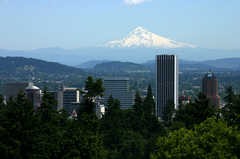Green cities in the US refer not only to an attempt to integrate the environment into the concerns of city planning, but also attempts at greening the economy of these cities. The measures that are applied to rank the cities include:
*public/private incubators for clean technology industries
* renewable energy
* advanced transportation
* advanced water treatment
* alternative fuels
*green building
*energy efficiency
It is said that “these indicators gauge, for instance, which cities’ public transit, renewable energy, local food, and development approaches are more likely to either limit or intensify the negative economic and environmental impacts of fossil fuel dependence.” Although these goals are admirable, they are really only concerned with a soft green economy, and don’t go close to the total economic transformation which seems to be called for if cities are going to continue to thrive into the future as places for human settlement.


Fascinating, and I would like to someone to produce comparable rankings for (1) countries (2) cities in other countries (3) political leaders (4) individuals.
For example, Britain’s curernt Prime Minister and London’s Mayor would get points because they are cyclists (and his predecessor was well-known for using public transport). Though it lagged for a very long time, London is now notable for the rapid increase in cycling as a means of transport – but it is not in the list of the world’s top eleven cycling cities. Portland comes second on this list, just as it does on the Green Cities list – but the Green Cities list does not mention its prowess as a cycling city!
Obama might get some points if he helps his wife grow vegetables in the White House garden. Are there any world leaders who grow their own veg, preferably wearing sandals and muttering ‘In the sweat of thy face shalt thou eat bread, till thou return unto the ground; for out of it wast thou taken: for dust thou art, and unto dust shalt thou return.’?
Gandhi was famous for wearing sandals. [ http://imgs.sfgate.com/c/pictures/2009/03/04/ba-us-gandhi_auc_0499857178.jpg ] Here is a photo of him wearing ones he made himself outside 10 Downing Street. [ http://www.allaboutshoes.ca/en/paduka/diversity_continuity/index_2.php ]
The ‘making of sandals’ was a comment on the caste system in India in which the activity was viewed as polluting.
So I suppose in considering the economies of cities, the classic questions of Marxism and Capitalism etc arise…or perhaps it is time for a new way of thinking about questions of production and consumption?
And perhaps attention needs to paid to material and immaterial culture in considering symbolic actions!
[ http://www.allaboutshoes.ca/en/paduka/in_footsteps_divine/ ]
Gandhi is a great example and most certainly was NOT Churchill’s finest hour when he remarked: “It is alarming and also nauseating to see Mr. Gandhi, a seditious middle temple lawyer, now posing as a fakir of a type well known in the east, striding half-naked up the steps of the viceregal palace, while he is still organizing and conducting a defiant campaign of civil disobedience, to parley on equal terms with the representative of the king-emperor.” BUT he built the brick wall for his own vegetable garden at Chartwell so we should try to forgive and forget.
I think the world could be a better place if all world leaders grew their own vegetables – and I rather like the idea of them appearing on election posters in their swimsuits (like Tony Blair).
What particular ‘electable’ quality do you suggest we should look for in the ‘swimwear’ section of an election campaign?